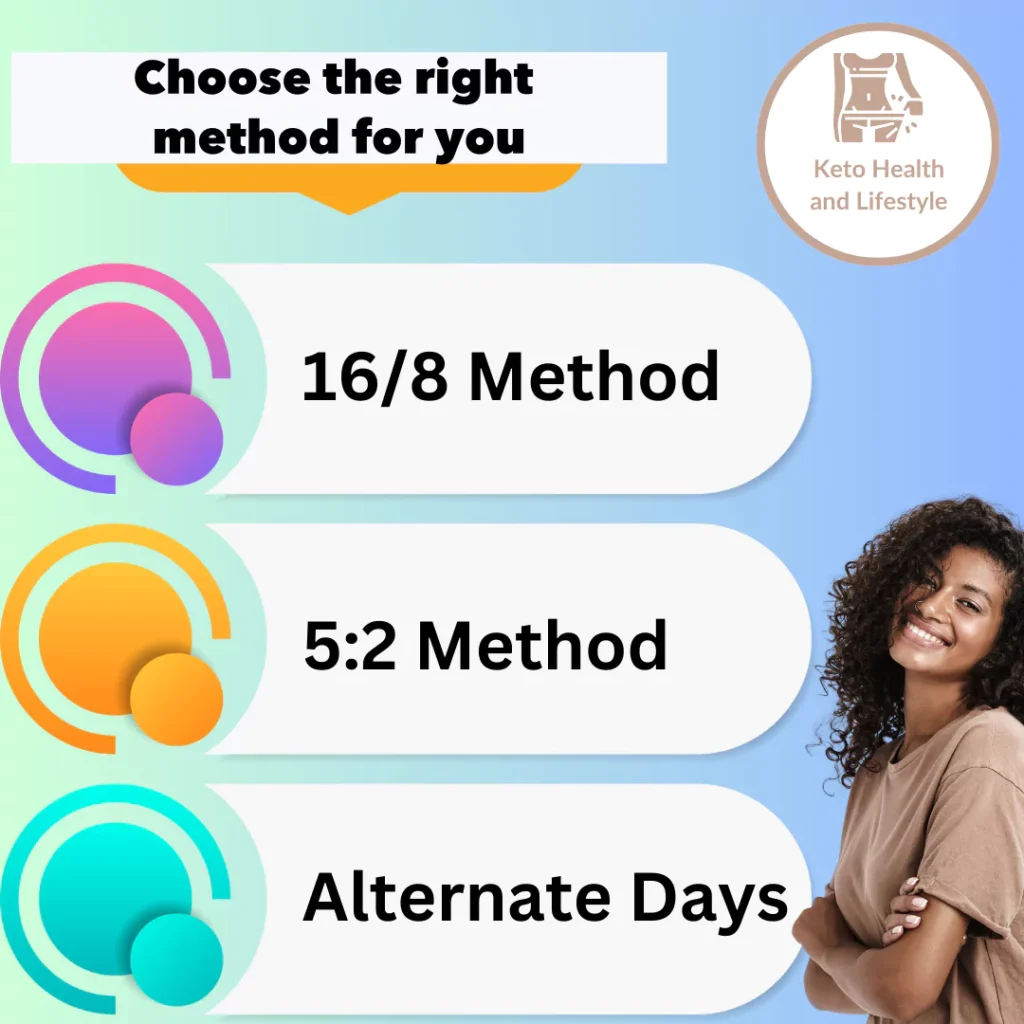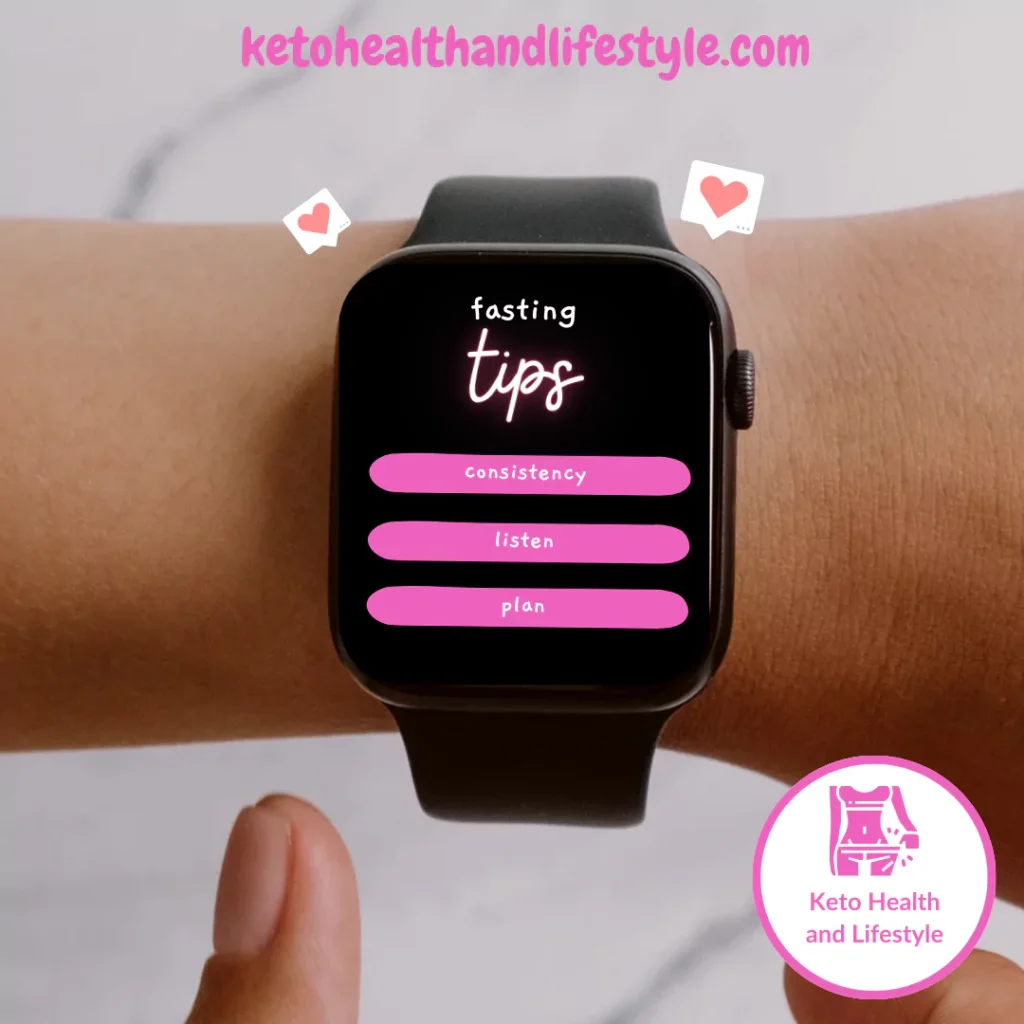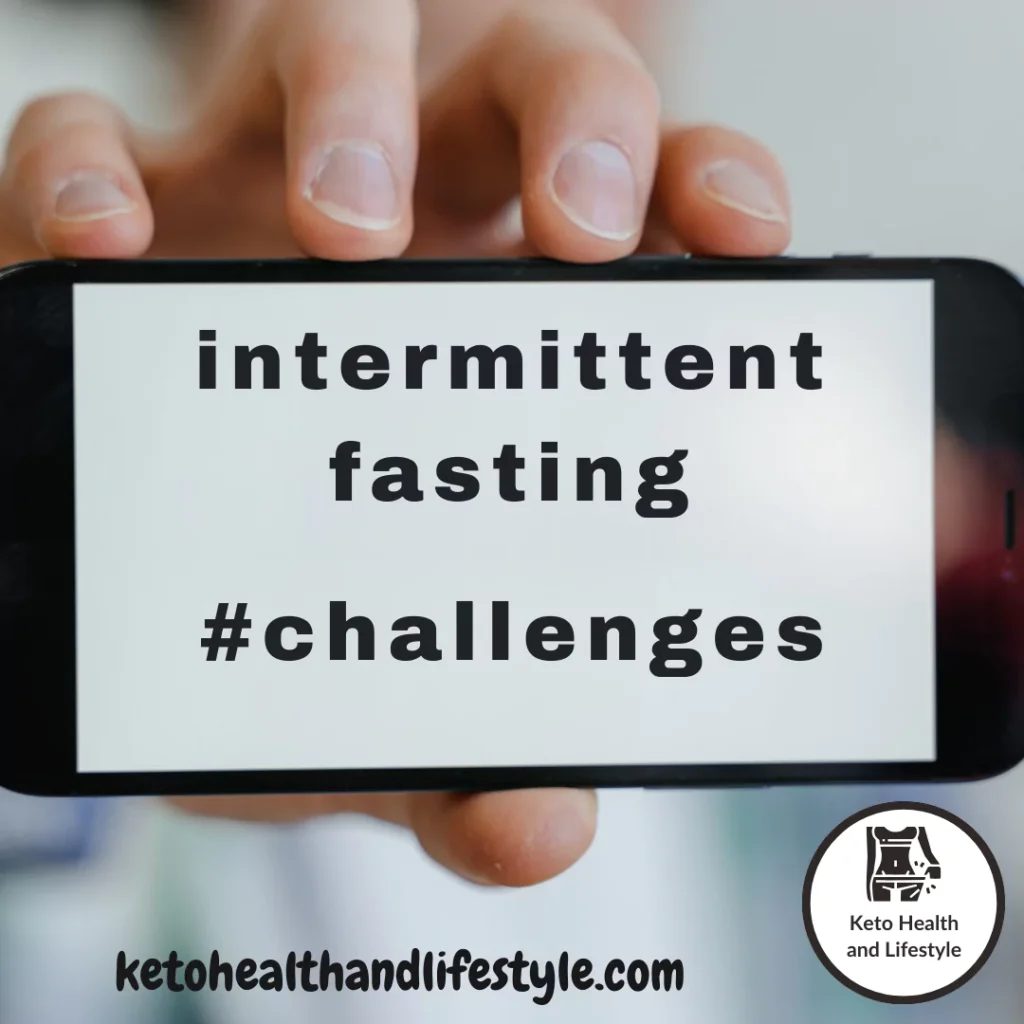This post may contain affiliate links which means I may receive a commission for purchases made through links. Learn more about policies on my about page.
TL;DR Summary for Busy Readers
- Key Benefits: Enhances weight loss, improves mental clarity, and boosts energy levels.
- How to Start: Begin with a 16/8 fasting schedule and gradually incorporate a ketogenic diet.
- Essential Tips: Stay hydrated, monitor your electrolytes, and listen to your body.
Table of Contents
Intermittent Fasting and Keto Diet
Combining intermittent fasting with keto lifestyle has captured the attention of many health enthusiasts. The keto diet, rich in fats and very low in carbs, already pushes your body into ketosis, where it burns fat for fuel. Adding intermittent fasting can amplify these effects, potentially speeding up the transition into ketosis and enhancing fat loss. If you’re keen on optimising your weight loss and metabolic health, this powerful combination might be the strategy you need. Stay tuned to discover how these two approaches can work together to supercharge your health journey.
Understanding Intermittent Fasting
Intermittent fasting (IF) is a popular eating pattern where you cycle between periods of eating and fasting. It’s not about what you eat, but when you eat. By giving your body time to burn off the calories and switch to fat stores, intermittent fasting can be highly effective for weight loss and overall health. Let’s look at some common methods and see which might fit your lifestyle best.
Popular Intermittent Fasting Methods
Understanding the various methods of intermittent fasting is key to picking the right one for you. Here’s a look at three of the most popular methods: 16/8, 5:2, and alternate-day fasting.
16/8 Method
The 16/8 method of fasting involves fasting for 16 hours and eating within an 8-hour window. This approach is often as simple as skipping breakfast and eating your first meal around noon and your last meal by 8 PM.
One of the reasons the 16/8 method is quite popular is its simplicity and integration into daily life with minimal disruption. It’s especially effective for those who already tend to skip breakfast and can be easily paired with a keto lifestyle since both focus on regulating insulin levels.
Here are a few benefits:
- Flexibility: Easily fits into most schedules.
- Ease of compliance: Doesn’t require calorie counting.
- Compatibility with keto: Encourages fat-burning processes.
5:2 Method
The 5:2 method of fasting involves eating normally for five days of the week and restricting calories to about 500-600 on the other two days. The fasting days can be any two non-consecutive days of the week, making it a convenient option for many people.
This method is like having a mini diet within your week. It can be great for those who struggle with daily fasting and prefer substantial meals on most days.
Be mindful of these points:
- Moderation: Easier to maintain long-term.
- Spaced out fasting: Less frequent, but significant calorie reduction.
- Variety: Allows for more varied meal planning.
Alternate-Day Fasting
Alternate-day fasting (ADF) involves fasting every other day. On fasting days, some versions allow up to 500 calories, while others go for a complete fast. On non-fasting days, normal eating is permitted.
This method can be more challenging due to its strict nature but can yield impressive results for those who can adhere to it.
Consider these aspects:
- Rapid results: Can be very effective for weight loss.
- Strict adherence required: Can be tough to maintain.
- Potential health benefits: May provide more significant health benefits due to the extended fasting periods.

Choosing the Right Method for You
Different lifestyles and personal preferences mean that one method may suit you better than another. Here’s a quick summary to help you decide:
- Busy schedules: 16/8 might be ideal.
- Varied eating: 5:2 offers flexibility.
- Quick results: Alternate-Day Fasting may be best but requires commitment.
For further information, you can check out these methods of intermittent fasting in detail and see which fits you best.
What is the Keto Diet?
The keto diet, short for ketogenic diet, is a low-carb, high-fat eating plan. This diet is designed to make your body enter a state called ketosis. When in ketosis, your body burns fat for energy instead of carbohydrates. Many people choose the keto diet to lose weight, boost energy levels, and increase mental clarity.
Benefits of the Keto Diet
The keto diet has several health benefits. Here are some of the most notable ones:
Weight Loss
One of the primary reasons people try the keto diet is its effectiveness in promoting weight loss. By reducing carbs and increasing fat intake, the body is forced to burn stored fat for energy. This can help you lose weight without feeling hungry all the time.
Improved Energy Levels
When following a keto diet, your energy levels can become more stable. Without the spikes and crashes that come from eating high-carb foods, you’ll likely feel more energised throughout the day. Think of it as switching from a roller coaster ride to a smooth highway drive.
Mental Clarity
Many people report better focus and mental clarity on the keto diet. When your brain is running on ketones instead of glucose, it might work more efficiently. Imagine your brain shifting from a flickering candle to a bright LED light.
If you’re curious to learn more about what the keto diet involves, check out this detailed beginner’s guide.
The keto diet isn’t just a fad—it’s a lifestyle change that can offer numerous benefits for your body and mind, making it an excellent option to pair with intermittent fasting on keto for even more significant results.
If you want to explore the varied aspects and potential challenges of the keto diet, the BBC Good Food guide offers a comprehensive look at how to start and what to expect.
The Synergy of Intermittent Fasting and Keto
Combining intermittent fasting with a ketogenic diet can supercharge your health journey. Both methods are powerful on their own, but together they create a synergy that enhances fat burning, promotes metabolic health, and supports sustainable weight loss. Let’s explore how these two strategies complement each other.
How Fasting Enhances Ketosis
Intermittent fasting and keto work hand-in-hand to speed up the process of entering ketosis, a metabolic state where your body burns fat for fuel instead of carbohydrates. But how exactly does fasting help?
When you fast, your body depletes its glycogen stores, forcing it to start burning fat for energy. This transition is crucial for reaching ketosis more quickly. Essentially, fasting:
- Depletes Glycogen: With reduced glycogen, your body switches to burning fat, accelerating ketosis source.
- Boosts Ketone Production: Fasting increases the production of ketones, which are used by your brain and muscles for energy source.
- Reduces Insulin Levels: Lower insulin levels during fasting promote fat breakdown, making it easier for your body to enter and maintain ketosis source.
Potential Health Benefits
Combining intermittent fasting with a keto diet enhances numerous health benefits. Studies have shown that this powerful duo can lead to:
- Accelerated Weight Loss: Intermittent fasting on keto can boost weight loss by enhancing fat burning and reducing overall calorie intake source.
- Improved Metabolic Health: This combination improves insulin sensitivity and lowers blood sugar levels, reducing the risk of type 2 diabetes source.
- Enhanced Mental Clarity: The increase in ketones provides a steady supply of energy to the brain, enhancing cognitive function and focus source.
In summary, intermittent fasting and keto are a match made in dietary heaven. They work together to enhance fat burning, improve metabolic health, and support sustainable weight loss. If you’re looking to boost your health journey, combining these two strategies might just be the key.

Getting Started: Tips for Combining Intermittent Fasting and Keto
Combining intermittent fasting and a keto lifestyle can be a powerful way to enhance weight loss, boost energy, and improve overall well-being. However, getting started the right way is crucial for long-term success. Here are some essential tips to help you combine intermittent fasting and keto effectively.
Start with Keto First
Before diving into intermittent fasting, it’s vital to get your body well-adapted to the keto diet. When your body enters ketosis, it burns fat for energy instead of carbs. This transition takes time, and it’s best to make it smooth. By starting with keto first, your body will adjust to the new fuel source, making fasting periods easier to manage. According to LifeApps, adapting to the keto diet first helps minimise hunger during fasting.
Timing Your Meals
Planning your meals and fasting periods is key to success. Here are some tips to help you time your meals efficiently:
- Choose a Fasting Window: Start with a smaller fasting window, like 12 hours, and gradually increase it to 16 or 18 hours. This gradual increase helps your body adapt without feeling overwhelmed.
- Match Meals to Your Schedule: Align your meals with your lifestyle. If you’re busy in the mornings, skip breakfast and have a hearty lunch and dinner.
- Stay Consistent: Try to keep your eating and fasting windows consistent every day to maintain a steady rhythm.
You can find an excellent guide on meal planning for intermittent fasting here.
Monitoring Your Progress
Effective tracking is essential to understand how your body responds to intermittent fasting on keto. Here’s how to monitor your progress:
- Keep a Food Journal: Note down what you eat and when you eat it. This helps identify any patterns or triggers affecting your progress.
- Use Health Apps: Apps like MyFitnessPal or Carb Manager can help you track your macros, fasting windows, and overall progress.
- Measure Ketone Levels: Use ketone strips or meters to measure your ketone levels. This helps ensure you’re in ketosis, maximising fat burning.
Tips for Success
Stay Consistent
Consistency is crucial. Stick to your fasting and eating windows even on weekends or special occasions. This practice will help your body adjust and deliver better results over time.
Listen to Your Body
Your body will give you signals. If you feel overly tired, dizzy, or unwell, it may be time to adjust your fasting window or increase your food intake. Remember, everyone’s body responds differently.
Plan Your Meals
Preparing keto-friendly meals in advance can help you avoid temptation. Make sure you have easy-to-grab snacks like nuts, cheese, or keto-friendly granola bars on hand.
Stay Active
Regular exercise complements your intermittent fasting and keto efforts. It doesn’t have to be intense; even a daily walk can enhance the benefits. Physical activity helps boost your metabolism and improve your overall health.
By integrating these tips into your routine, you’ll set yourself up for success as you combine intermittent fasting on keto. For more detailed insights on how both methods work together, check this insightful article on Healthline.
Combining intermittent fasting with a keto diet can be daunting at first, but with the right approach, it becomes manageable and highly rewarding. Start slow, stay consistent, and listen to your body for the best results.

Common Challenges and How to Overcome Them
Embarking on the journey of intermittent fasting on keto can come with its unique set of challenges. However, understanding these challenges and knowing how to tackle them can make the process smoother and more rewarding. Below, we dive into some common issues faced and practical solutions to overcome them.
Managing Hunger and Cravings
One of the most common challenges when combining intermittent fasting with a keto lifestyle is dealing with hunger pangs and cravings. It’s tough, but manageable with the right strategies:
- Stay Hydrated: Drinking plenty of water can help you feel full and reduce feelings of hunger. Sometimes, what feels like hunger is actually dehydration.
- Electrolyte Balance: Keeping your electrolytes balanced can significantly reduce hunger pangs. Supplements or foods rich in electrolytes can be beneficial. This article by Dr. Berg explains how to manage cravings effectively.
- High-Fat Snacks: When you do eat, make sure your snacks are high in healthy fats. Foods like avocados, nuts, and keto-friendly cheese can keep you satiated for longer.
- Herbal Teas: Drinking herbal teas can also help curb appetite. Peppermint and ginger tea, for example, are great options during fasting periods.
- Mindful Eating: When you break your fast, eat slowly and savour your food. This can help you feel more satisfied and less likely to overeat.
Learning to listen to your body and understanding that hunger comes in waves can also help you push through the tough moments.
Maintaining Energy Levels
Balancing energy levels while fasting and adhering to a keto diet can be tricky. However, there are effective ways to keep your energy up throughout the day:
- Proper Nutrition: Ensure your meals are nutrient-dense. Foods like leafy greens, fatty fish, and keto-friendly vegetables are essential. Healthline’s guide offers some excellent tips on combining intermittent fasting with keto for optimal results.
- Stay Active: Light exercise like walking or yoga can help maintain your energy levels. Intense workouts might need to be timed around your eating periods.
- Consistent Sleep Routine: Getting enough quality sleep is crucial. Lack of sleep can lead to increased hunger and lower energy levels.
- Caffeine in Moderation: Coffee or tea can provide a necessary boost, but avoid excessive consumption as it can sometimes lead to energy crashes.
- Scheduled Eating Windows: Stick to a consistent eating and fasting schedule to help your body adapt. The consistency can help maintain steady energy levels throughout the day.
By following these tips, you can ensure that you’re not only staying full but also maintaining peak energy throughout your fasting and keto journey. It’s all about finding what works best for your body and sticking to it.
Conclusion
Combining intermittent fasting with a keto lifestyle can be a powerful strategy for those looking to enhance their weight loss efforts, improve metabolic health, and simplify their dietary habits. By syncing the benefits of these two approaches, you can achieve remarkable results that might not be possible with either method alone.
Why This Combination Works
Intermittent fasting on keto offers a synergistic effect that helps you reach your goals faster and more efficiently. Here’s a quick overview of why this combination is so effective:
- Enhanced Fat Burning: Both intermittent fasting and keto encourage your body to burn fat for energy instead of carbs. This not only helps you lose weight but also increases energy levels.
- Easier Ketosis: Fasting depletes your body’s glycogen stores, pushing you into ketosis more quickly. This means you can reap the benefits of ketosis without waiting as long.
- Improved Metabolic Health: Reducing insulin spikes through both fasting and a low-carb diet can help improve insulin sensitivity and reduce the risk of metabolic syndrome.
Practical Tips to Get Started
If you decide to try intermittent fasting on keto, there are a few things to keep in mind to maximize your success:
- Choose Your Fasting Window: Start with a more manageable fasting window, like 12 hours, and gradually increase to 16 or 18 hours as your body adapts. Wholesome Yum also provides a beginner-friendly guide.
- Stay Hydrated: Keep drinking plenty of water throughout the day. Herbal teas and black coffee can also help curb hunger during fasting periods.
- Plan Your Meals: Make sure your meals during eating periods are rich in healthy fats, moderate in protein, and low in carbs. This ensures you stay in ketosis and get all the nutrients you need.
Benefits Backed by Research
Combining intermittent fasting and keto isn’t just a trend; it’s backed by scientific research. Some of the documented benefits include:
- Improved Brain Function: Ketones are a more efficient fuel for your brain, potentially improving cognitive functions and reducing brain fog.
- Longevity: Both methods activate autophagy, which is the body’s way of cleaning out damaged cells and regenerating new ones. This can contribute to improved longevity and overall health.
- Reduced Inflammation: Both keto and intermittent fasting have been shown to reduce inflammation markers in the body, which can lead to a decrease in chronic diseases.
Final Thoughts
Combining intermittent fasting with a keto lifestyle can be a game-changer for your health and weight loss journey. By understanding how these two powerful methods complement each other, you can create a sustainable and effective plan that works best for you. Listen to your body, make adjustments as needed, and enjoy the many benefits that come with this dynamic duo.
Remember to let your body tell you what is good. I automatically moved into the 16/8 fasting period as I normally eat only one meal a day (OMAD).
Keep the momentum going! Dive into my handpicked recommended reading below for more insights and inspiration!
Further recommended reading:
What is Ketosis? A Comprehensive Guide
Engage with the fundamental concepts behind ketosis and how your body benefits from this metabolic state. This guide will provide you with a thorough understanding of ketosis, which is crucial when combining it with intermittent fasting. Read more about understanding ketosis
Net Carbs vs Total Carbs: Key Differences for Keto
Learn the differences between net carbs and total carbs and why they matter on a keto diet. This knowledge is essential for anyone fasting intermittently to maintain ketosis effectively. Discover the key differences in carb counting
Week 7 Keto Diet Results: Success Stories and Lessons
Explore real-life experiences and results from the 7-week keto diet. These insights can be incredibly motivating for those looking to combine intermittent fasting with keto. See the success stories and lessons from a 7-week keto journey

